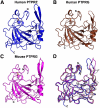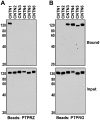The protein tyrosine phosphatases PTPRZ and PTPRG bind to distinct members of the contactin family of neural recognition molecules
- PMID: 20133774
- PMCID: PMC2823867
- DOI: 10.1073/pnas.0911235107
The protein tyrosine phosphatases PTPRZ and PTPRG bind to distinct members of the contactin family of neural recognition molecules
Abstract
The receptor protein tyrosine phosphatases gamma (PTPRG) and zeta (PTPRZ) are expressed primarily in the nervous system and mediate cell adhesion and signaling events during development. We report here the crystal structures of the carbonic anhydrase-like domains of PTPRZ and PTPRG and show that these domains interact directly with the second and third immunoglobulin repeats of the members of the contactin (CNTN) family of neural recognition molecules. Interestingly, these receptors exhibit distinct specificities: PTPRZ binds only to CNTN1, whereas PTPRG interacts with CNTN3, 4, 5, and 6. Furthermore, we present crystal structures of the four N-terminal immunoglobulin repeats of mouse CNTN4 both alone and in complex with the carbonic anhydrase-like domain of mouse PTPRG. In these structures, the N-terminal region of CNTN4 adopts a horseshoe-like conformation found also in CNTN2 and most likely in all CNTNs. This restrained conformation of the second and third immunoglobulin domains creates a binding site that is conserved among CNTN3, 4, 5, and 6. This site contacts a discrete region of PTPRG composed primarily of an extended beta-hairpin loop found in both PTPRG and PTPRZ. Overall, these findings implicate PTPRG, PTPRZ and CNTNs as a group of receptors and ligands involved in the manifold recognition events that underlie the construction of neural networks.
Conflict of interest statement
The authors declare no conflict of interest.
Figures






Similar articles
-
A complex between contactin-1 and the protein tyrosine phosphatase PTPRZ controls the development of oligodendrocyte precursor cells.Proc Natl Acad Sci U S A. 2011 Oct 18;108(42):17498-503. doi: 10.1073/pnas.1108774108. Epub 2011 Oct 3. Proc Natl Acad Sci U S A. 2011. PMID: 21969550 Free PMC article.
-
Structural Basis for Interactions Between Contactin Family Members and Protein-tyrosine Phosphatase Receptor Type G in Neural Tissues.J Biol Chem. 2016 Oct 7;291(41):21335-21349. doi: 10.1074/jbc.M116.742163. Epub 2016 Aug 18. J Biol Chem. 2016. PMID: 27539848 Free PMC article.
-
Loss-of-function of PTPR γ and ζ, observed in sporadic schizophrenia, causes brain region-specific deregulation of monoamine levels and altered behavior in mice.Psychopharmacology (Berl). 2017 Feb;234(4):575-587. doi: 10.1007/s00213-016-4490-8. Epub 2016 Dec 26. Psychopharmacology (Berl). 2017. PMID: 28025742
-
A Comprehensive Review of Receptor-Type Tyrosine-Protein Phosphatase Gamma (PTPRG) Role in Health and Non-Neoplastic Disease.Biomolecules. 2022 Jan 6;12(1):84. doi: 10.3390/biom12010084. Biomolecules. 2022. PMID: 35053232 Free PMC article. Review.
-
Carbonic anhydrase related proteins: molecular biology and evolution.Subcell Biochem. 2014;75:135-56. doi: 10.1007/978-94-007-7359-2_8. Subcell Biochem. 2014. PMID: 24146378 Review.
Cited by
-
A novel computational biostatistics approach implies impaired dephosphorylation of growth factor receptors as associated with severity of autism.Transl Psychiatry. 2014 Jan 28;4(1):e354. doi: 10.1038/tp.2013.124. Transl Psychiatry. 2014. PMID: 24473445 Free PMC article.
-
A Glycosylphosphatidylinositol-Anchored Carbonic Anhydrase-Related Protein of Toxoplasma gondii Is Important for Rhoptry Biogenesis and Virulence.mSphere. 2017 May 17;2(3):e00027-17. doi: 10.1128/mSphere.00027-17. eCollection 2017 May-Jun. mSphere. 2017. PMID: 28529974 Free PMC article.
-
Proteomic Study of Aqueous Humor and Its Application in the Treatment of Neovascular Glaucoma.Front Mol Biosci. 2020 Oct 8;7:587677. doi: 10.3389/fmolb.2020.587677. eCollection 2020. Front Mol Biosci. 2020. PMID: 33195434 Free PMC article.
-
Receptor protein tyrosine phosphatases are novel components of a polycystin complex.Biochim Biophys Acta. 2011 Oct;1812(10):1225-38. doi: 10.1016/j.bbadis.2010.11.006. Epub 2010 Nov 29. Biochim Biophys Acta. 2011. PMID: 21126580 Free PMC article.
-
Contactin-1 reduces E-cadherin expression via activating AKT in lung cancer.PLoS One. 2013 May 28;8(5):e65463. doi: 10.1371/journal.pone.0065463. Print 2013. PLoS One. 2013. PMID: 23724143 Free PMC article.
References
MeSH terms
Substances
Associated data
- Actions
- Actions
- Actions
- Actions
LinkOut - more resources
Full Text Sources
Other Literature Sources
Molecular Biology Databases
Miscellaneous

